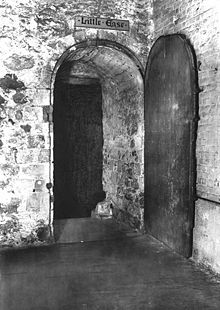Little Ease
The English term Little Ease ( German for "little comfort") describes a method of torture practiced in Europe in the Middle Ages . The prisoner was locked in a very small cell or hole in which he could neither stand nor lie.
There were several Little Eases in the Tower of London . The dimensions were 45 cm in width, 120 cm in height and 60 cm in depth. For example, Guy Fawkes (1570-1606), explosives expert in the gunpowder conspiracy Gunpowder Plot of November 5, 1605, was tortured in one of these cells for 50 days before betraying his co-conspirators. Edmund Campion (1540–1581) was tortured for four days in a 4 × 4 foot Little Ease in the Tower of London to renounce the Catholic faith.
Individual evidence
- ^ J. Langbein, Torture and the Law of Proof: Europe and England in the Ancien Regime. , University of Chicago, 1976.
- ^ W. Thornbury, The Tower: (part 1 of 2). In Old and New London , 2/1878, pp. 60-76.
- ^ Dungeons and Torture: The Tower of London. ( Memento of the original from February 2, 2016 in the Internet Archive ) Info: The archive link was automatically inserted and not yet checked. Please check the original and archive link according to the instructions and then remove this notice. , dated February 8, 2008
- ^ JV Holleran, A Jesuit Challenge: Edmund Campion's Debates at the Tower of London in 1581. , Fordham Univ. Press, 1999, p. 35. ISBN 0-823-21887-2
- ↑ The Press At Stonor ( Memento of the original from May 11, 2008 in the Internet Archive ) Info: The archive link was inserted automatically and has not yet been checked. Please check the original and archive link according to the instructions and then remove this notice.
literature
- G. Fox, Autobiography of George Fox (English) [1] [2] (PDF; 2.2 MB)
- EH Carkeet-James, Her Majesty's Tower of London. , London: Staples Press, 1953.
Web links
- st-andrews.ac.uk , picture by Little Ease in the Tower of London
